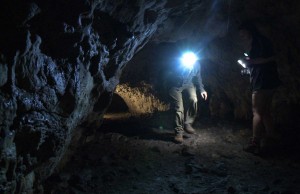
Bean has made research documentaries his specialty and has already shot numerous archeology films under extreme conditions. However, the documentary in the Undo Cave in the southern Caucasus still proved to be a great challenge for the cinematographer. “To make filming in the complete darkness of the cave passages possible at all, we had to rely on dependable lighting equipment,” said Bean. “That’s why the MicroPro camera light by Litepanels was the perfect companion for our project.”
“The light can be easily mounted on the camera, is compact and really lightweight,” explained Bean who often had to worm his way through the narrow passageways of the cave on his knees or in a crouched position. “During filming, I really put the light to the test. I touched the walls or the ceiling in the narrow cave with the light several times. Once, it even fell down. But the light took the hits. The damp environment was also no obstacle for it.”
The Litepanels light was used in the cave as well as when filming interviews with the archaeologists in front of the cave. “The LED light provided the right light no matter what the requirements were: in the cave as a key light and during the interviews as a fill light, which I adjusted with color gels,” said Bean.
The MicroPro provides bright, soft and flicker-free daylight. With the color gels included in the set-up, the color temperature can be easily adjusted to the respective lighting conditions. “The possibility of powering the lights with a battery belt was especially practical for us. This way I was able to follow the archaeologists deep into the cave and didn’t have to worry about suddenly standing in the dark with the camera,” Bean added.





